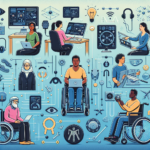-
Table of Contents
“Empowering Trust in a Connected World”
Introduction

The Future of Digital Identity Management is poised to revolutionize the way individuals and organizations authenticate and protect personal information in an increasingly interconnected world. As digital interactions become more prevalent, the need for secure, efficient, and user-friendly identity solutions has never been greater. Emerging technologies such as blockchain, biometrics, and decentralized identity systems promise to enhance privacy, reduce fraud, and streamline access to services. This evolution will not only safeguard personal data but also empower users with greater control over their digital identities, fostering trust and innovation in the digital economy.
The Role Of Blockchain In Digital Identity Management
As the digital landscape continues to evolve, the need for secure and efficient identity management has never been more critical. Traditional methods of managing digital identities, such as passwords and centralized databases, are increasingly proving to be inadequate in the face of sophisticated cyber threats. This is where blockchain technology comes into play, offering a promising solution to the challenges of digital identity management.
Blockchain, the technology underpinning cryptocurrencies like Bitcoin, is essentially a decentralized ledger that records transactions across multiple computers. This decentralization ensures that no single entity has control over the entire database, making it inherently more secure against hacking and data breaches. In the context of digital identity management, blockchain can provide a more secure, transparent, and user-centric approach.
One of the primary advantages of using blockchain for digital identity management is its ability to eliminate the need for intermediaries. Traditional identity verification processes often involve multiple parties, each adding a layer of complexity and potential vulnerability. With blockchain, individuals can have direct control over their own identities, reducing the risk of data breaches and identity theft. This self-sovereign identity model allows users to store their personal information on a blockchain and share it with trusted parties as needed, without relying on a central authority.
Moreover, blockchain’s immutability ensures that once data is recorded, it cannot be altered or tampered with. This feature is particularly valuable for maintaining the integrity of identity information. For instance, once a user’s identity is verified and recorded on the blockchain, it becomes a permanent and unchangeable record. This not only enhances security but also simplifies the verification process for future transactions, as the information can be easily accessed and trusted.
In addition to security, blockchain can also improve the efficiency of identity management. Traditional systems often require users to repeatedly verify their identities for different services, leading to a cumbersome and time-consuming process. Blockchain can streamline this by enabling a single, verifiable digital identity that can be used across multiple platforms. This not only saves time for users but also reduces the administrative burden on service providers.
Furthermore, blockchain’s transparency can foster greater trust between users and service providers. In a blockchain-based identity system, all transactions and changes to identity information are recorded on a public ledger, which can be audited by anyone. This transparency ensures that users have full visibility into how their data is being used and can hold service providers accountable for any misuse.
However, despite its potential, the adoption of blockchain for digital identity management is not without challenges. One of the main hurdles is the need for widespread acceptance and standardization. For blockchain-based identity systems to be effective, they must be interoperable across different platforms and jurisdictions. This requires collaboration between governments, businesses, and technology providers to develop common standards and protocols.
Additionally, there are concerns about privacy and data protection. While blockchain can enhance security, it also raises questions about how personal information is stored and shared. Ensuring that blockchain-based identity systems comply with data protection regulations, such as the General Data Protection Regulation (GDPR), is crucial to gaining user trust and acceptance.
In conclusion, blockchain technology holds significant promise for revolutionizing digital identity management. By providing a more secure, efficient, and transparent approach, it can address many of the shortcomings of traditional systems. However, realizing this potential will require overcoming challenges related to standardization, interoperability, and data protection. As the digital world continues to grow, the role of blockchain in digital identity management is likely to become increasingly important, paving the way for a more secure and user-centric future.
Biometric Authentication: The Future Of Secure Digital Identities
In an era where digital interactions are becoming increasingly integral to our daily lives, the need for secure and efficient identity management has never been more critical. As we navigate through this digital landscape, biometric authentication is emerging as a promising solution for safeguarding our digital identities. This technology, which leverages unique biological traits such as fingerprints, facial recognition, and iris scans, offers a level of security that traditional methods like passwords and PINs simply cannot match.
One of the primary advantages of biometric authentication is its inherent uniqueness. Unlike passwords, which can be forgotten, stolen, or hacked, biometric traits are intrinsic to the individual. This makes it significantly harder for malicious actors to replicate or compromise these identifiers. For instance, while a password can be guessed or phished, a fingerprint or facial pattern is much more difficult to forge. Consequently, this reduces the risk of unauthorized access and enhances the overall security of digital systems.
Moreover, the convenience of biometric authentication cannot be overstated. In a world where users are required to remember an ever-growing list of passwords, the simplicity of using a fingerprint or facial scan to unlock devices and access services is a welcome relief. This ease of use not only improves the user experience but also encourages the adoption of more secure practices. As a result, individuals are less likely to resort to weak passwords or other insecure methods, further bolstering the security of their digital identities.
Transitioning to biometric authentication also aligns with the broader trend towards seamless and frictionless user experiences. As technology continues to evolve, there is a growing expectation for interactions to be quick and effortless. Biometric systems, with their ability to provide instant verification, fit perfectly into this paradigm. Whether it’s unlocking a smartphone, accessing a bank account, or verifying identity for online transactions, the speed and efficiency of biometric authentication are unparalleled.
However, the adoption of biometric authentication is not without its challenges. Privacy concerns are at the forefront of the debate, as the collection and storage of biometric data raise significant questions about data security and user consent. Ensuring that this sensitive information is protected from breaches and misuse is paramount. To address these concerns, companies and developers are investing in advanced encryption techniques and decentralized storage solutions, which aim to safeguard biometric data while maintaining user privacy.
Furthermore, the accuracy and reliability of biometric systems are crucial for their widespread acceptance. While the technology has made significant strides, there are still instances where biometric systems may fail to recognize an individual or produce false positives. Continuous advancements in machine learning and artificial intelligence are helping to mitigate these issues, improving the precision and dependability of biometric authentication.
As we look to the future, the integration of biometric authentication with other emerging technologies holds exciting potential. For example, combining biometrics with blockchain technology could create a decentralized and tamper-proof system for managing digital identities. This synergy could further enhance security and provide users with greater control over their personal information.
In conclusion, biometric authentication represents a significant leap forward in the quest for secure digital identities. Its unique combination of security, convenience, and efficiency makes it an attractive option for both users and organizations. While challenges remain, ongoing innovations and a commitment to privacy and accuracy are paving the way for a future where biometric authentication becomes the standard for digital identity management. As we continue to embrace this technology, we can look forward to a more secure and seamless digital experience.
Decentralized Identity Systems: Empowering Users In The Digital Age
In an era where our lives are increasingly intertwined with the digital world, the management of digital identities has become a critical issue. Traditional centralized identity systems, which rely on a single entity to manage and verify identities, have long been the norm. However, these systems are fraught with vulnerabilities, including data breaches, identity theft, and a lack of user control. As a result, there is a growing interest in decentralized identity systems, which promise to empower users by giving them greater control over their personal information.
Decentralized identity systems, often built on blockchain technology, offer a new paradigm for managing digital identities. Unlike centralized systems, where a single entity holds all the power, decentralized systems distribute control across a network of participants. This not only enhances security but also ensures that users retain ownership of their data. By leveraging cryptographic techniques, these systems allow individuals to prove their identity without revealing unnecessary personal information, thereby protecting their privacy.
One of the key advantages of decentralized identity systems is their ability to reduce the risk of data breaches. In centralized systems, a single point of failure can lead to the exposure of millions of users’ data. In contrast, decentralized systems distribute data across multiple nodes, making it significantly harder for hackers to compromise the entire network. Moreover, because users control their own data, they can choose what information to share and with whom, further minimizing the risk of unauthorized access.
Another significant benefit is the potential for increased user autonomy. In traditional systems, users often have little say in how their data is used or shared. Decentralized identity systems, however, put users in the driver’s seat. They can manage their identities through digital wallets, deciding which credentials to share and when. This not only enhances privacy but also fosters a sense of empowerment, as individuals regain control over their digital lives.
The implications of decentralized identity systems extend beyond individual users. For businesses, these systems can streamline processes and reduce costs associated with identity verification. By eliminating the need for intermediaries, companies can conduct transactions more efficiently and securely. Additionally, decentralized identities can facilitate seamless interactions across different platforms and services, creating a more interconnected digital ecosystem.
Governments, too, stand to benefit from the adoption of decentralized identity systems. By providing citizens with secure and verifiable digital identities, governments can improve the delivery of public services and reduce fraud. For instance, decentralized identities can simplify the process of voting, ensuring that only eligible individuals participate while maintaining voter privacy. Similarly, they can enhance the efficiency of social welfare programs by ensuring that benefits reach the intended recipients.
Despite the promise of decentralized identity systems, challenges remain. One of the primary hurdles is achieving widespread adoption. For these systems to be effective, they require a critical mass of users and service providers. This necessitates collaboration across various sectors, including technology, finance, and government. Additionally, there are technical challenges to address, such as ensuring interoperability between different decentralized identity solutions and maintaining the security of the underlying infrastructure.
Nevertheless, the momentum behind decentralized identity systems is growing. As awareness of their benefits increases, more organizations and individuals are likely to embrace this innovative approach to digital identity management. By empowering users and enhancing security, decentralized identity systems have the potential to transform the digital landscape, creating a future where individuals have greater control over their personal information and can navigate the digital world with confidence.
Conclusion
The future of digital identity management is poised to be shaped by advancements in blockchain technology, biometric authentication, and decentralized identity systems. These innovations promise to enhance security, privacy, and user control over personal data. As digital interactions become increasingly integral to daily life, robust identity management solutions will be essential to protect against cyber threats and ensure seamless, trustworthy online experiences. The integration of artificial intelligence and machine learning will further refine identity verification processes, making them more efficient and adaptive. Overall, the evolution of digital identity management will be crucial in fostering a secure and user-centric digital ecosystem.





